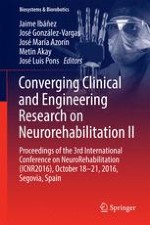2017 | OriginalPaper | Buchkapitel
The CP Walker for Strength Training in Children with Spastic Cerebral Palsy: A Training Program Proposal
verfasst von : Teresa Martín Lorenzo, Sergio Lerma Lara, Cristina Bayón, Oscar Ramírez, Eduardo Rocon
Erschienen in: Converging Clinical and Engineering Research on Neurorehabilitation II
Aktivieren Sie unsere intelligente Suche, um passende Fachinhalte oder Patente zu finden.
Wählen Sie Textabschnitte aus um mit Künstlicher Intelligenz passenden Patente zu finden. powered by
Markieren Sie Textabschnitte, um KI-gestützt weitere passende Inhalte zu finden. powered by
